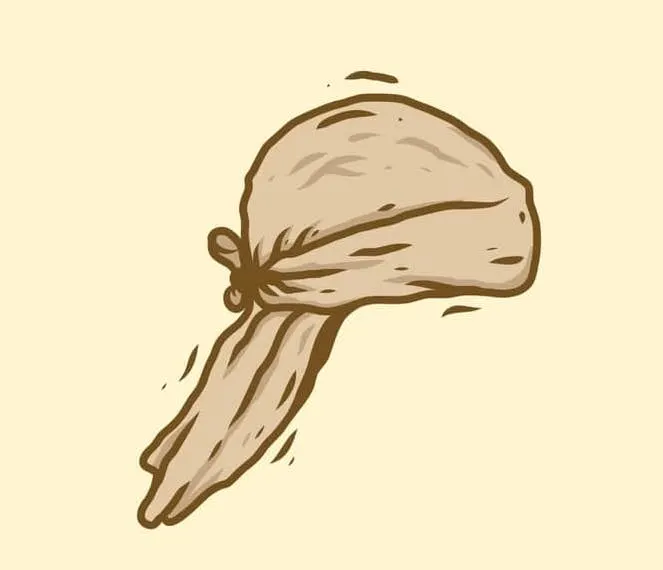Unless you wear them frequently, not many people are aware of the differences between these two titans of headwear. So, what’s the difference between durags and bandanas?
Durags are more fitting than bandanas. They conform more closely to the shape of the head and have ties and a flap at the back, unlike bandanas which are simple pieces of cloth. While durags are only worn on the head, bandanas are more versatile and can also be worn around the neck or face.
The physical difference means that durags are often used for hairstyle protection purposes. Bandanas, on the other hand, may be more likely used as helmet liners for bikers or sweatbands.

Image From Deposit Photos
This is the general gist, but we will go into the differences and similarities between durags and bandanas in more detail in this article, and when to choose one over the other.
It’s definitely worth having one of each in your wardrobe.
Durag Vs Bandana: 3 Differences
The main difference between durags and bandanas is the presence or absence of ties and the shape of the cloth.
But there are also a couple of other relevant differences that we’ll discuss here.
Both types of headwear also have very different histories and paths to their popularisation – but we won’t go into this today as this is a whole other topic that deserves its own article.
1. Shape
As mentioned before, durags are form-fitting pieces of headwear that conform closely to the shape of your head. They also usually have a flap covering the neck and ties at the back of the head so that they can be secured in place.
Here are examples of durags on

Bandanas, on the other hand, are triangular or square-shaped pieces of cloth that can be tied around the head.
They are also usually tied at the back of the head, but unlike durags they don’t have separate ties. Instead, the corners of the cloth triangle are used as ties.
Here’s a bandana on

The shape differences mean that durags can be easier to slip on and off than bandanas, and tend to stay put better once they’re on.
This is why durags are great at keeping hairstyles intact, such as the 360 waves cut.
2. Material
Bandanas are usually made of predominantly cotton material, and occasionally polyester. They are traditionally red in color and decorated with a white paisley pattern, but nowadays many other colors such as blue, yellow, and black are widely available.
Their cotton-predominant make up means they tend to be less stretchy than durags.
With durags, you have more choice when it comes to the material- durags can be found in velvet, silk, mesh, and acrylic-polyester synthetic materials.
This makes durags more suitable to be worn at night as certain materials such as silk tend to be less abrasive to hair. It also means you can adapt durags more easily for both summer and winter wear by getting them in both light and heavier materials.
Bandanas, on the other hand, may be more suited to sweatband use, as cotton is a breathable fabric that absorbs sweat, compared with silk which is less absorbent.
3. How It’s Worn
Because of their shape, durags are only really designed to be worn on the head.
Bandanas are more versatile when it comes to how you want to wear them, as the square or triangular fabric can be shaped in multiple ways.
Bandana wearers often wear their bandana in a similar way to the durag, tying the ends at the back of their head and using it to cover most of their scalp. But they can also wear bandanas as a necktie, a headband, and even as a face covering if they so wish.

Image From deposit Photos
This variety in style options is an attractive feature of the bandana and can be why people choose to wear them for certain sports activities.
3 Similarities Between Durags And Bandanas
The similarities between durags and bandanas are mostly obvious, and it’s really their subtle differences that make each type of headwear stand out.
But we will briefly highlight their similarities before moving on to how and when to choose one over another.
1. They Both Tame Your Hair.
Both durags and bandanas are essentially types of headwear that can be used to keep your hair out of your face.
In fact, many people choose to wear durags or bandanas to keep flyaways from getting into their eyes and mouth, and they are pretty much interchangeable for this purpose.
For bandanas, this means tying them around the base of your head in a similar fashion to a durag.
Both durags and bandanas can also prevent your hair from getting tangled when worn if you find yourself in a blustery situation outdoors.
This can save you a great deal of time and effort trying to brush out those pesky knots.
2. They Can Keep You Warm
When used as head coverings underneath helmets or hats, durags and bandanas both offer an extra layer of insulation for your scalp.
This is particularly useful in the colder months, or if you are going to be riding a bike outdoors for several hours in the wind and potentially rain.
3. You Can Use Both To Make A Style Statement
As we’ve already mentioned, bandanas come in various bright colors and patterns that are easily available nowadays.
Durags also can be found in different colors and can be patterned too, like bandanas.
Some people use these patterned or bright-colored durags and bandanas to make a style statement, and can really accentuate and individualize their outfit.
Both bandanas and durags can therefore be used for style as well as function.
Durag Vs Bandana: Which One Should You Choose?
We’ve gone through the basics of what durags and bandanas are, and some of the differences and similarities between them.
Let’s now discuss what you really want to know – how do you choose between the two and when should you choose one over the other?
Let’s get into some of the factors you should consider.
1. Hairstyle Protection
When it comes to choosing between a durag and a bandana, it really comes down to what your priorities are.
For some people, hairstyle protection and maintenance is their number 1 concern. If this resonates with you, then durags are going to be your best bet.
You might hear people talking about ‘spinning waves’ – this is the process by which you can get the 360 waves style. Durags are a crucial part of this process, so if you want to achieve or maintain the 360 waves style, then a durag is the best option for you.
It’s not just 360 waves that durags are great for – they are also good at maintaining braids and straightened hair, and can protect these hairstyles from humidity and rainy weather during the day.
Bandanas don’t have the same compression effect on your hair that durags do, so they aren’t used for the 360 waves style.
Bandanas also don’t tend to stay put as well as durags do, so they aren’t really suitable for hairstyle protection, where having headwear with minimal movement to keep your hairstyle in place is a priority.
So if you need headwear that is going to protect and help style your hair, choose a durag.
2. Versatility
For some people, having a type of headwear with multiple functions is just what they need.
This is a reason why many bikers choose bandanas over durags.
Bandanas can not only be worn as a fashion statement but also as a sweatband, helmet protection for hair, skin protection for the sun, and as a face covering to protect you from dust.
Many bikers also use bandanas to wipe down their motorcycle mirrors, wipe down the seat after it has rained, or use them to insulate their hands if they need to reach down near the hot pipes of their bike.
They can also be dipped in water and wrapped around your neck to keep you cool, or used as a neck covering to keep you warm in the colder weather.
As you can see, this versatility of function is ideal for a sport such as biking, where you can’t afford to carry too many heavy tools or accessories with you.
Durags, although some bikers do choose to use them, are less versatile when it comes to their function due to their shape, which is designed specifically for use as headwear.
3. Improving Hair Texture
Some people use types of headwear purely for hair improvement purposes.
If you’re choosing between a durag and a bandana, your best option for achieving this goal is the durag.
Durags not only help to develop and maintain 360 waves, but also improve the texture of your hair when worn overnight.
Because of their compression effect, durags lock in moisture into your hair that would otherwise escape if left uncovered overnight.
They can also reduce breakage from friction between your hair and pillowcase by limiting the movement of your hair.
Paired with the application of moisturizing hair oils before going to bed, this can improve the smoothness and texture of your hair.
Bandanas are less suitable for this purpose, simply because they don’t tend to stay in place as well as durags because of their shape.
People often move at night in their sleep and unfortunately, bandanas can’t deal with this movement without becoming displaced as well as durags can.
4. Playing Sports
When it comes to these two types of headwear and playing sports, both can be good options in their own different ways.
You can’t go too wrong choosing between the two for this purpose.
Bandanas, as I’ve touched on before, are usually made out of cotton or cotton-predominant material. Cotton is good at absorbing moisture, so when playing sports it can keep sweat off of your skin allowing it to remain cool.
Bandanas also will protect your forehead and scalp from the sun’s rays if you’re playing an outdoor sport where regular sunscreen applications aren’t as practical.
Another plus point of wearing a bandana when it comes to playing sport is that it can keep the hair out of your eyes.
You’ll often see tennis players and soccer players wearing bandanas that neatly keep the hair from falling into their face and obscuring their vision.
Durags, on the other hand, can also be a great option when playing sports.
Similar to bandanas, durags can effectively keep your hair from falling into your face.
As durags come in a variety of materials, you can find certain materials that are better at absorbing sweat from your brow, which can be an annoying distraction when trying to focus on your game.
Avoid heavier velvet or silk materials and choose durags made with more breathable fabrics to maximize sweat-absorbing ability.
As durags are typically worn lower on the brow than bandanas, they can also absorb sweat over a larger surface area. This also means good sun protection for your forehead too.
As you can see, both bandanas and durags have similar benefits for playing sports. Either one is suitable for this purpose and it often comes down to preference.
Both also come in different colors and patterns, which is handy if you want another way to show off your team colors.
Conclusion
Hopefully, this article has made things a little clearer now.
When it comes down to it, both durags and bandanas are types of stylish headwear that have slightly different but overlapping functions.
Which you choose is down to you, but as both are generally affordable, I suggest having one of each in your wardrobe so that you can be prepared for any occasion.
Ready Sleek founder. Obsessed with casual style and the minimalist approach to building a highly functional wardrobe. Also a fan of classic, vintage hairstyles.







